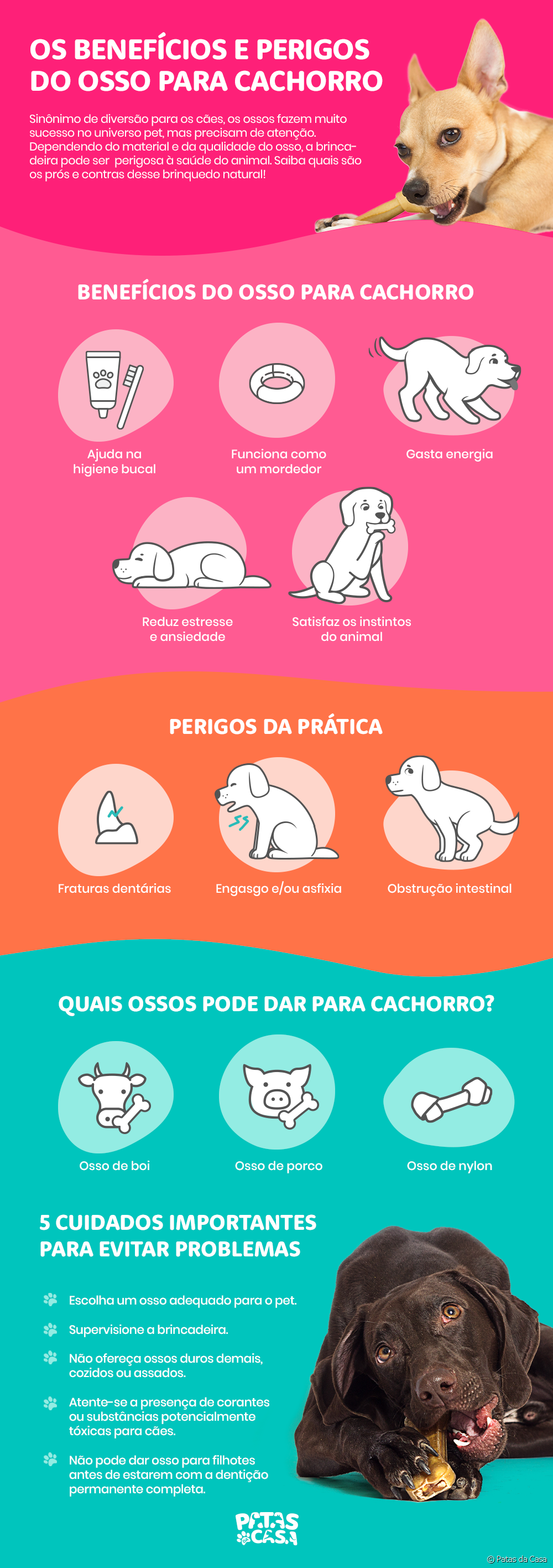Can you give a dog a bone? infographic shows the pros and cons

Table of contents
Dogs don't need anything too expensive or modern to play and have fun, and the dog bone is one of the greatest proofs of that. Just come up with a little bone, and the animal can spend hours gnawing on it without worrying about anything else. But despite the entertainment that the dog bone offers, it is important to also think about the consequences that the game can bring if it does not have the right accessories.care required.
With that in mind, we have prepared an infographic explaining everything about the different types of bone - natural, smoked, nylon and leather - as well as the advantages and disadvantages of inserting the piece in your dog's routine. Check it out!

After all, can you give a dog a bone to chew or not?
One of the biggest doubts of the guardians is to find out if hooves and bones for dogs are safe or not. This is because, despite being very appreciated by our furry friends, these "toys" can cause several very unpleasant problems for the health of these animals if they are used improperly. But let's go by parts, ok?!
To begin with, there is no reason to demonize the bone. Dogs like to gnaw and play with it, and if the guardian is careful, the piece will hardly pose any danger to the pet. In fact, there are several benefits to offering bones to dogs, such as energy expenditure - after all, the dog will spend a lot of time playing with it - and the reduction of stress and anxiety. In addition, the bones have a goodsimilar function to the dog biter, massaging the gums and satisfying the pet's biting needs. The accessory also helps with dental hygiene, preventing problems such as plaque and tartar formation in dogs.
On the other hand, there are some downsides to using bone. If the material is too rigid, it can result in a broken dog tooth, while if the dog bone is too "brittle", it will break easily and risk being swallowed by the animal, leaving the dog choking or even causing a choke. There is also the danger of swallowing small broken pieces that mayperforate the pet's digestive system or cause an intestinal obstruction.
Types of dog bone: know which to use (and which to avoid!)
Natural bone for dogs: The most recommended are beef or pork bones, which provide a large amount of cartilage and even meat, and are usually larger and not in danger of being swallowed. Chicken bones should be avoided, as they are very fragile and small.
See_also: Urinary infection in dogs: what are the causes, signs, complications and how to treat the problem?Nylon bone for dog: this is a toy that is very successful and fits into the list of types of teethers. The model is made of materials that are not toxic to dogs, and can be harder or softer. Because it is made of nylon, it should not be consumed by the animal, just serve as entertainment during play.
Smoked bone for dog: These are usually natural dog bones, but they may come with preservatives, spices and artificial flavourings during smoking. This process also often ends up making the bone more fragile and brittle. All of this can harm animal health, so it should be avoided.
Leather dog bone: this is also not one of the best options to offer your dog. In addition to undergoing different chemical processes, leather bones are difficult for the body to digest and can leave the dog with diarrhea, for example.
See_also: Friday the 13th: black cats need to be protected on this dayYou can offer bone to dog, as long as it is done carefully
If you're thinking of giving your dog a bone to gnaw on, be careful. We've already seen that, although it seems like a harmless game, the little bones come with some dangers. Therefore, one of the main tips for not having any problems is to always choose pieces that are appropriate for the dog - and it's even good to talk to a veterinarian before making that decision on your own. Even with the release ofa professional, another important precaution is to supervise play as a precaution.
Also, always avoid bones that are broken, brittle, too hard or have been cooked/baked. This means that that leftover lunch can't go straight to your dog, okay? When the bone is cooked or baked, it ends up getting brittle. Also be sure to watch for the presence of toxic substances for dogs in the bone.
Finally, a warning: do not offer bones to puppies, especially if the animal is in the process of changing teeth or does not yet have all permanent teeth. In this case, the best thing to do is to look for teethers that are really suitable for the animal's phase.

